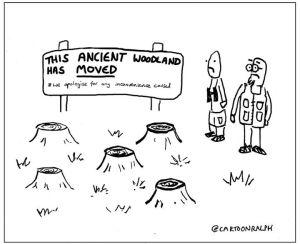 Biodiversity offsets are becoming more popular in Australia and elsewhere as a means to raise money for conservation and restoration while simultaneously promoting economic development (1). However, there are many perverse consequences for biodiversity if they are not set up carefully (1-3).
Biodiversity offsets are becoming more popular in Australia and elsewhere as a means to raise money for conservation and restoration while simultaneously promoting economic development (1). However, there are many perverse consequences for biodiversity if they are not set up carefully (1-3).
Biodiversity ‘offsets’ are intended to work in a similar way to carbon offsets1, in that the destruction of a part of an ecosystem (e.g., a native forest or grassland, or a wetland) can be offset by paying to fund the restoration of another, similar ecosystem elsewhere. As such, approval to clear native vegetation usually comes with financial and other conditions.
But there are several problems with biodiversity offsetting, including the inconvenient fact that creating an equivalent ecosystem somewhere takes substantially longer than it does to destroy one somewhere else (e.g., 4). While carbon emitted in one place is essentially the same as that sequestered elsewhere, a forest can take hundreds of years to develop the same biodiversity values and ecological functions it had prior to destruction.

Thus, while biodiversity offsetting might look good on paper, and it can provide funding for restoration projects (which is decidedly attractive to those of us pushing for more restoration), it has to be done following a strict set of rules (7) for it to have any hope of maintaining biodiversity in the long run. The conclusion is that biodiversity offsetting should only be used sparingly, if at all, and only under the strictest set of rules and supervision.
References
- Maron M, Gordon A, Mackey BG, Possingham HP, Watson JEM (2015) Stop misuse of biodiversity offsets. Nature 523:401-403
- Nature Conservation Council of NSW (2016) Paradise Lost – The weakening and widening of NSW biodiversity offsetting schemes, 2005-2016 (Nature Conservation Council of New South Wales, Sydney, Australia)
- Bekessy SA, et al. (2010) The biodiversity bank cannot be a lending bank. Conservation Letters 3:151-158
-
Martin PA, Newton AC, Bullock JM (2013) Carbon pools recover more quickly than plant biodiversity in tropical secondary forests. Proceedings of the Royal Society B: Biological Sciences 280:20132236
-
Apostolopoulou E, Adams WM (2017) Biodiversity offsetting and conservation: reframing nature to save it. Oryx 51:23-31
-
Walker S, Brower Ann L, Stephens RTT, Lee William G (2009) Why bartering biodiversity fails. Conservation Letters 2:149-157
-
Maron M, et al.(2012) Faustian bargains? Restoration realities in the context of biodiversity offset policies. Biological Conservation 155:141-148

